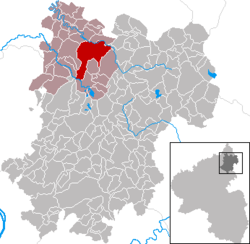Hachenburg
| Hachenburg | ||
|---|---|---|

Hachenburg Castle
|
||
|
||
| Coordinates: 50°39′41″N 7°49′13″E / 50.66139°N 7.82028°ECoordinates: 50°39′41″N 7°49′13″E / 50.66139°N 7.82028°E | ||
| Country | Germany | |
| State | Rhineland-Palatinate | |
| District | Westerwaldkreis | |
| Municipal assoc. | Hachenburg | |
| Government | ||
| • Mayor | Peter Klöckner (SPD) | |
| Area | ||
| • Total | 21.43 km2 (8.27 sq mi) | |
| Elevation | 350 m (1,150 ft) | |
| Population (2015-12-31) | ||
| • Total | 5,888 | |
| • Density | 270/km2 (710/sq mi) | |
| Time zone | CET/CEST (UTC+1/+2) | |
| Postal codes | 57627 | |
| Dialling codes | 02662 | |
| Vehicle registration | WW | |
| Website | www.hachenburg.de | |
Hachenburg is a town in the Westerwaldkreis in Rhineland-Palatinate, Germany.
The town lies in the Westerwald between Koblenz and Siegen, roughly 10 km west of Bad Marienberg on the river Nister. Hachenburg is the administrative seat of the Verbandsgemeinde of Hachenburg, a kind of collective municipality (See Verbandsgemeinde).
The castle (Schloss), former seat of the Counts of Sayn, was founded about 1180 by Count Heinrich II of Sayn.
Building was finished in 1212 under Count Heinrich III, the founder’s son, who was also mentioned as the town’s and the castle’s first owner. At the same time, under the Count’s overlordship, came the building of the neighbouring Marienstatt Cistercian Monastery.
In 1314, Hachenburg, whose name comes from a castle hill protected by thornbushes, was granted town rights. The original settlement lay not on the 390-m-high castle hill, but rather some 1.5 km away in the dale about 100 m lower through which runs the Rothbach, on the site of what is now the outlying constituent community of Altstadt (which explains its name – Altstadt is German for “Old Town”), which had its first documentary mention in 1343. The Romanesque St. Bartolomäuskirche, built there about 1200 and nowadays an Evangelical church is Hachenburg’s oldest preserved building, followed by the Steinernes Haus (“Stone House”), known as Zur Krone, from the 15th century, at the Old Market (Alter Markt) in the town centre. The castle church only arose in the late 15th century and underwent several remodellings until the 18th century. The Catholic church Maria Himmelfahrt, from the early 18th century, belonged at first to a Franciscan monastery, but later, in 1813, became the parish church. In the Middle Ages, the town’s population was most likely never more than about 500 to 1,000, and in the 17th and 18th centuries it was between 1,000 and 1,500. Only after the Second World War did this small town’s population reach first 3,000, and nowadays almost 6,000.
...
Wikipedia



